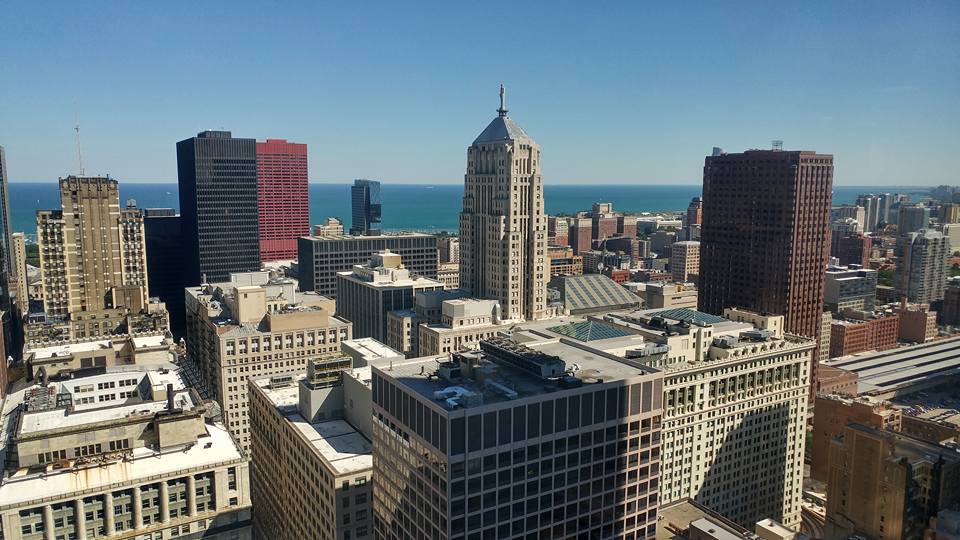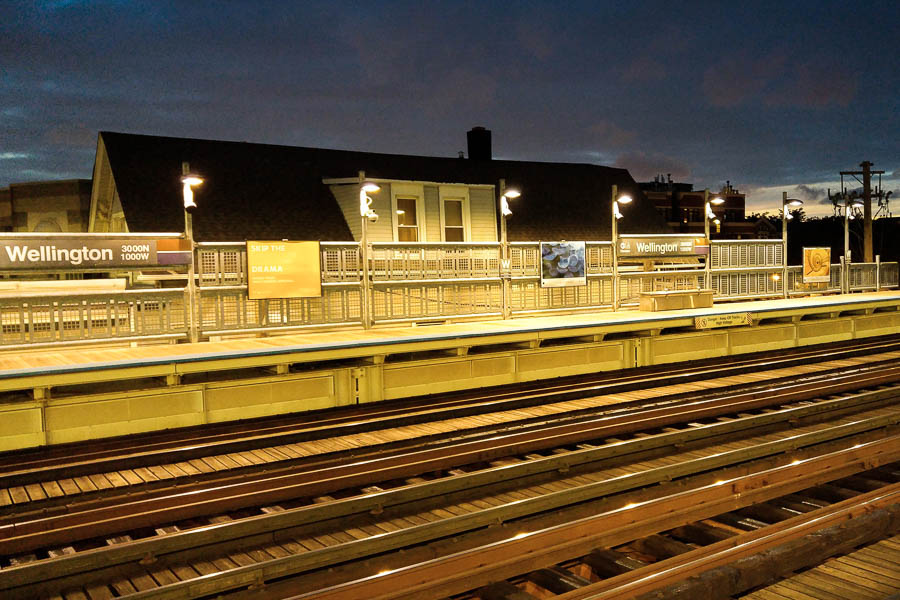At work, I typically sit at an east-facing window on the 35th floor of the Sears Willis Tower. Here's my view:

That means I can often see Michigan, Indiana, and everything in between, including very large boats out on the Lake. For the last half-hour I've watched a huge white thing slowly steam South, wondering what it was. It turns out, there's a website for that. And the boat is, in fact, pretty big:

So the 138-meter Glostrander is puttering southward at 19 km/h towards South Chicago. Good to know. (You can see the boat in the photo above just to the left of the Board of Trade building. It's the white horizontal sliver close to the horizon.)
The Economist has found that craft breweries are inversely correlated with religiosity in the US:
Some states are craftier than others. Atop the list of craft breweries per capita is Vermont, with 44 of them crammed into one of the nation’s smallest and least populated states. In addition to being better liquored, Vermonters are a good bit more godless than the national average. This reflects a broader trend: there is a markedly negative correlation between a state’s religiosity and breweries per person.
Local regulations determine the level of production much more than demographic characteristics such as income or education, says Bart Watson, chief economist of the Brewers Association, a craft-beer trade organisation. And religious legislators may get a bit overzealous. Utah, a state populated with many teetotaling Mormons, strictly limits the strength of draught beers and cocktails.
As you'd expect from that newspaper, they have a cool chart, too.
Usually I just link to articles I haven't read yet. This morning, here's a list of videos friends have posted. (They take longer than articles.)
And, OK, one article: Politico interviewed dozens of people who were involved with getting the president home on 9/11, fifteen years ago today. Their accounts are riveting.
Workers digging London's Crossrail tunnel have helped uncover a 350-year-old mystery about the Great Plague:
[T]he Great Plague...killed 100,000 Londoners (roughly a quarter of the city’s population) around 350 years ago.
Last year, workers constructing a future new ticket hall at Liverpool Street Station unearthed a charnel pit adjoining the old Bedlam Hospital, in which 3,000 skeletons were interred. Now it turns out that some of these skeletons had the answer to a centuries’ old mystery, hidden away in their teeth.
Scientists at Germany's Max Planck Institute took samples from the teeth of 20 of these corpses, and this week confirmed what historians have long suspected but been unable to prove: London's Great Plague was caused by the Yersinia Pestis bacteria, exactly the same pestilence that killed around one-third of Europe's population in the 14th century, under the name the Black Death.
The BBC has more.
I've been meaning to post this photo from July. No story behind it; I just think it's cool.

It's fascinating how working from home doesn't seem to give me more time to, you know, work. So these have backed up on me, and I hope to read them...someday:
OK, so, that's going to take a few minutes...
It turns out, no one wants to buy ugly big houses in the far suburbs. This apparently comes as a shock to their owners:
The McMansion style, built between 2001 and 2007 and averaging 3,000 to 5,000 square feet, lacks the appeal with today's buyers compared to old vintage homes or large freshly built homes.
The realization is especially hard on homeowners trying to sell because when they bought the giant homes in the early 2000s, they thought of them as great investments, Feinstein said.
Then, the idea was that bigger was better because prices presumably would keep going up.
Now, housing analysts say the day of the McMansion has come and gone. An analysis just completed by Trulia shows that the amount buyers are willing to pay for McMansions over other homes has fallen 26 percent in just four years. As homes in general have been regaining value, McMansions have been losing appeal in comparison to others as the giants of the pre-crash years have aged.
No kidding. And no sympathy from me. Fools, money, etc.
Airways magazine has the heartwarming story of American Airlines MD-80 N9401W heading off to retirement in New Mexico:
This aircraft, and 19 others, were part of a symbolic retirement.
A 20-aircraft order placed by American Airlines to McDonnell Douglas in 1982 marked the beginning of an era in which AA became the world’s largest MD-80 operator, but as the decades passed through and as new and more efficient aircraft joined the fleet, the venerable Mad Dog era is now heading into the sunset.
Once the last AA MD-80 parks in Roswell in 2018, it will close a chapter in the company’s history; yet it will also signify a new era, with the arrival of new Airbus A320 family aircraft and Boeing 737 Next Generation and the coming MAX variant, all part of a major $4.6 billion order placed back in 2010 for 460 aircraft —the largest commercial aircraft order in history at that time.
Millions of miles had unfurled beneath Ship 4WJ, from the Far East where she was built, to freezing Calgary in Canada to the sunny Los Cabos in Mexico, from Los Angeles to Chicago, and then to New York, transporting about 3,700,000 passengers during its career.
Subtracting engines, the current parts market value of an MD-80 varies from $100,000 to $200,000. Once all marketable parts have been harvested, the value of the fuselage carcass ranges between $10,000 and $12,000. It can take a month to part out an MD-80 yet only a few hours to crush it into scrap metal.
While AA retired today 20 MD-80s, the airline’s remaining 61 Mad Dogswill continue flying—safely and reliably transporting their passengers and crews.
I last flew on an MD-80 on 3 December 2014, from Dallas to Chicago.
Two stories, in two directions. First, a cool interactive history of how the construction of Chicago's Eisenhower Expressway (I-290) displaced thousands of people and destroyed thousands of buildings:
In the late 1940s, the Oak Leaves newspaper in Oak Park predicted that the new superhighway would replace the West Side’s “appalling slums” with “orderly dwellings where orderly people are living in health and comfort.”
Of all the neighborhoods that the expressway sliced through, the Near West Side had the largest population of blacks in 1950. Nearly 40 percent of its people were African-American.
In February 1949, city housing coordinator D.E. Macklemann said some people in the neighborhood simply didn’t believe that the highway would actually get built. “One man forced us to get an eviction order from the court because he said he had been reading about superhighways for years and thought the whole thing was a dream,” Macklemann told the Tribune. “In several instances residents paid no attention until the buildings next door were being torn down.”
Second, a report about how Rochester, N.Y., has followed San Francisco, Boston, and other cities in burying or removing highways that blighted or isolated their downtowns:
Rochester lucked out. The eastern quadrant of the Inner Loop was isolated from the main flow of traffic into the city, and thus, the traffic volume on that segment of highway was never particularly high. As a result, discussions about burying this portion of the Inner Loop weren’t sidetracked by circular debates about what to do with the traffic it would displace. It may have taken decades to move forward, but that’s still more progress than many cities can claim.
Our research at the University of Connecticut shows that cities that transformed their downtowns with freeways, parking, and monolithic developments were flooded with traffic even while they were losing jobs and residents. The few American cities that maintained most of their prewar urban fabric saw much less growth in traffic congestion and have retained their character as vibrant walking cities.
We also know that cities that have removed freeways—usually due to an act of nature—have seen a decrease in traffic congestion. In some cases, the decrease was more than 50 percent.
I hope that someday, years from now but in my lifetime, we'll see the Eisenhower buried as well. There have been proposals to do that in Oak Park almost since it was built. But that would require a commitment to livable spaces that the U.S. doesn't seem likely to make.
The UK's Daily Mail has a decent explanation and creepy photos of how the southernmost city in Illinois went from a thriving (and historical) port to a nearly-abandoned shell in 50 years:
The town's luck began to fall in 1889 when the Illinois Central Railroad bridge opened over the Ohio River - although much railroad activity was still routed through the town, so its effects were not severe.
The same can't be said for a second bridge that opened around 23 miles up the Mississippi at Thebes, Illinois in 1905.
The completion of that bridge drained away much railroad activity, reducing the need for the ferries that once carried railroad stock.
And with steamboats being phased out in favor of barges, Cairo was no longer the essential hub it had once been. The end had begun.
The town was hit again in 1929 and 1937 when bridges were completed across the Mississippi and Ohio rivers, respectively, allowing a route through for US Routes 51, 60 and 62.
As the bridges were built at the town's southern tip, it was easy for traffic to bypass Cairo completely, draining away more money.
But there was still a little money coming to the town until 1987, when the Interstate 57 bridge opened across the Mississippi, allowing traffic to bypass the town altogether - killing its hotel and restaurant industries.
I visited Cairo in 2003. It was pretty dead then, but judging by the photos in the Daily Mail article, it's even worse now.
Here's the confluence of the rivers, in December 2003:
